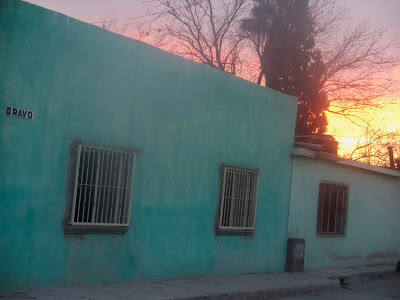The Sunday after Christmas, Hector lent us his Suburban and we headed up to a town called Castaños to attend church there. I am going to let Karl tell about it.
When I was a missionary, my camera was out of commission during the four months in this special town. Not a single picture made it home. Here at last are a few images of what might not look like much, but for me the place is sacred. You would need to read the memoir of my mission to understand why. Suffice it to say that it was a beautiful thing to spend a few hours in the town of my heart's desire.
First you see the lovely church building built for growth that still hasn't come to Castaños. We arrived late for 9:00 services, but church did not begin until 10:00. The second person I saw was someone I knew well, Pedro Ramirez, the branch president when I was there. I asked him if he remembered me, but he could not, which is understandable. Missionaries come and go, and it was almost twenty years ago. Still, stepping into the building was like stepping back in time. There were still just a handful of members, and it was still the kind of branch you could volunteer to speak and be given the floor; a new voice is always welcome in Castaños. From the pulpit, I recounted the memories of the time spent in their company.
Unlike her husband, Armida in fact remembered me well, pictured here on the left. She fed me at least weekly for four months. As if the schedule never lapsed, she invited us into her home again. I learned that all those meals were prepared on a wood stove which was only recently replaced by a gas one.

This is the beautiful pecan tree orchard between the Ramirez's house and the church. You used to be able to walk between the two through the orchard until someone put a fence up. It was such a soothing contrast to the big city of Monterrey where I spent most of my time as a missionary.
 I learned a little more about Pedro Ramirez on this occasion. He used to work for a steel factory in nearby Monclova along with most of the rest of the male population of Castaños. Now he is a custodian at an elementary school. He was orphaned at an early age with 7 siblings, too many for anyone to take in. They pretty much supported themselves and learned how to survive. His role in the flock has changed little; now he is the counselor in the branch presidency.
I learned a little more about Pedro Ramirez on this occasion. He used to work for a steel factory in nearby Monclova along with most of the rest of the male population of Castaños. Now he is a custodian at an elementary school. He was orphaned at an early age with 7 siblings, too many for anyone to take in. They pretty much supported themselves and learned how to survive. His role in the flock has changed little; now he is the counselor in the branch presidency. The rubik's cube was solved by Elena. She sometimes makes patterns and letters like alternating H and I.
 Marlene had her quinceñera party while I was serving in the area. For some absurd notion of missionary obedience, my companion and I chose not to go. Now, it seems it would have been well within the spirit of the work to have participated in the most significant social event during our sojourn in this town. She was home for Christmas from Orem, Utah where she works and studies. I asked her if she remembered me and at first she didn't think she could. But then she thought and said, "El era muy serio," he was very serious. I knew that in fact she had remembered for I was, during that phase of life, a somber, serious, quiet missionary.
Marlene had her quinceñera party while I was serving in the area. For some absurd notion of missionary obedience, my companion and I chose not to go. Now, it seems it would have been well within the spirit of the work to have participated in the most significant social event during our sojourn in this town. She was home for Christmas from Orem, Utah where she works and studies. I asked her if she remembered me and at first she didn't think she could. But then she thought and said, "El era muy serio," he was very serious. I knew that in fact she had remembered for I was, during that phase of life, a somber, serious, quiet missionary. Pedro Jr., Elena, Daniel, Chiara, Karl, Stephen, Pedro, Armida, Marlene, Joseph
To the best of my knowlege, this was our missionary pad. It was a studio apartment attached to the landlord's house. The rent was about $30 a month, divided by two, by far the cheapest place I have ever lived, about $.50 a night. It was also my favorite.
Something special happened on Calle Bravo. You would need to read the memoir to understand what. It is not something I can fully express with words, but perhaps the memoir will help you see why it is significant for me.
What would not a person give to capture a glimpse of heaven?





















































